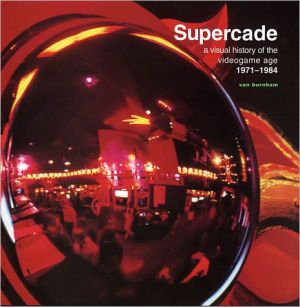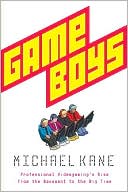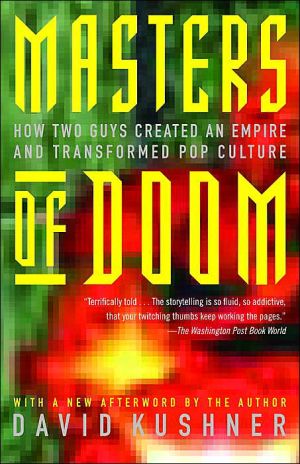Supercade: A Visual History of the Videogame Age 1971-1984
It was a time when technology was king, status was determined by your high score, and videogames were blitzing the world...From Pong to Pac-Man, Asteroids to Zaxxon—more than fifty million people around the world have come of age within the electronic flux of videogames, their subconscious forever etched with images projected from arcade and home videogame systems.From the first interactive blips of electronic light at Brookhaven National Labs and the creation of Spacewar! at the...
Search in google:
A gloriously illustrated history of the videogame and its legacy for both our mindscapes and video technology. Publishers Weekly The generation now in its 30s pumped innumerable quarters into free-standing video consoles with protruding joysticks, steering wheels, and "fire" buttons the quaint precursors of today's dollar-based sensory overload and sleekly sophisticated home systems. Burnham, an L.A.-based Wired contributing editor and a member of the Video Arcade Preservation Society, lovingly collects screen shots of faves like Space Invaders, Pac-Man and Q*bert, along with early games like Computer Space and Pong, and home games from Atari and Nintendo. The cheeky capsule descriptions of each game from Burnham and others are matched with longer essays from writers like Julian Dibble (My Tiny Life: Crime and Passion in a Virtual World), who writes about the text-based game Adventure, and former Feed editor Steven Johnson (Emergence) on Atari competitor Intellivision. The chronological organization holds the book's disparate games and players together adequately, but readers looking for a straight narrative history should look elsewhere: this is all about memory jogging and rapturous description. Notably, Burnham did the book's text, design and production; the layout is quirky and provocative but not disorienting, and the print quality is excellent. (Nov.) Forecast: While the book can't compete with the actual experience of playing the games, Burnham's time capsule will given as a gift among gamers (not a small subculture), and browsers from its demographic will at least flip through. The MIT imprint could lead to some campus acquisitions, especially for schools with modern media and culture departments. Copyright 2001 Cahners Business Information.
In the beginning there was MIT's Whirlwind and Bouncing Ball. Then, in 1958, physicist Willy Higinbotham created Tennis for Two for the annual Visitor's Day display at Brookhaven National Laboratory. It was likely the first interactive computer game, played out on a 5" black and white oscilloscope with control boxes to serve and rally a blip of electronic light. \ Then in 1961, an MIT student named Steve Russell programmed the first computer game Spacewar! on a DEC PDP-1. Inspired by E.E. "Doc" Smith's Lensman pulp science fiction novels, this space-age dogfight was played out on a CRT screen using the PDP's control panel switches to maneuver two warring spaceships as they orbit a gravitational sun.\ In the fall of 1966, Ralph H. Baer conceived of the first home videogame system utilizing a television set as a display. As chief engineer and manager of equipment design for Sanders Associates a military electronics consulting firm in Nashua, New Hampshire Baer begins to translate his idea for a "Television Gaming Apparatus" with fellow engineers Bill Harrison and Bill Rusch. After myriad iterations, including vacuum tube, IC, and transistor-based systems, they finally create the "Brown Box" prototype.\ In 1971, as a young Ampex engineer in Silicon Valley, Nolan Bushnell designs the first coin-operated arcade videogame Computer Space. As a student at the University of Utah, Bushnell played Spacewar! on the computer science lab's PDP system and dreamed of a day when arcade midways would be lined with machines offering a round of Spacewar! for a quarter. That same year, Ralph Baer's Brown Box technology is licensed to Magnavox and evolves into the world's first home videogame system the Magnavox Odyssey.\ It were these key events in the history of videogame technology that led to the creation of the twenty billion dollar interactive industry that exists today. The rest, as they say, is history...
Foreword17Introduction2101Brookhaven National Labs27Tennis for Two02MIT33Building 20TmrcThe Origin of Spacewar!Dictionary of the Tmrc Language03TV Game Project51Television Gaming ApparatusThe Brown Box04Timeline5605197165SyzygyComputer Space06197275AtariOdysseyPong07197389TV Ping-PongAsteroidGotchaPaddle BallRallySpace RaceWinner08197499Gran Trak 10Puppy PongQwak!ReboundSpeed RaceTankTouch Me091975111Atari PongOdyssey 100-5000Alley RallyAvengerGun FightManeaterShark JawsSteeplechase101976127TelstarChannel FAdventureBreakoutDeath RaceNight DriverSea WolfSprint 2Stunt Cycle111977147Atari VcsStudio IIApple IIPetTRS-80Canyon BomberCircusDrag RaceSafariStarship 1121978157The Professional ArcadeOdyssey[superscript 2]Atari FootballAvalancheBlastoFire TruckGee BeeSpace InvadersSpace Wars131979185IntellivisionAtari Home ComputersTI-99AsteroidsBasketballGalaxianGalaxy WarsLunar LanderRip OffSpeed FreakWarriorInterview: Tim Skelly141980209ActivisionGame & WatchBattlezoneBerzerkCarnivalCentipedeCrazy ClimberDefenderMissile CommandPac-ManPhoenixRadarscopeRed BaronSpace Invaders DeluxeStar CastleStratovox151981233Pac-Man FeverTwin GalaxiesInterview: Walter DayCosmosCommodore VIC-20Ibm PcDonkey KongFroggerGalagaGorfHangly ManJump BugKaosLady BugLock 'N ChaseMake TraxMouse TrapMS. PAC-MANPleiadsQixScrambleSpace OdysseyStargateTempestThiefTurboVanguardVentureWarlordsWizard of Wor161982277Gronk! Flash! Zap!ImagicAtari 5200ColecovisionVectrexCommodore 64Zx SpectrumBurgertimeDig DugDisco No. 1Donkey Kong JuniorJoustJungle KingKangarooMoon PatrolMr. DoPengoPole PositionPopeyePop FlamerQ*BertReactorRobotron: 2084Robby Roto!Satan's HollowSinistarTime PilotTronTutankhamWackoXeviousZaxxonZookeeperZzyzzyxx171983331StarcadeSG-1000Astron BeltCliff HangerCloak & DaggerCongo BongoCrystal CastlesCrossbowDragon's LairElevator ActionGyrussJourneyM.A.C.H. 3Major HavocMario BrosSpace AceSpy HunterStar TrekStar WarsTrack & FieldTropical AngelVan-Van Car181984371Atari 7800FamicomApple Macintosh720[degree]ExcitebikeI, RobotKarate ChampLode RunnerMarble MadnessPAC-LandPaperboyPunch Out!TapperSamurai NipponichiSnake PitTX-1Vs. Baseball19Collections40120Exhibits409Today412Resources422Index428Credits439Author442Contributors444
\ From the Publisher"Who can resist a book that opens by tying invention of the video game to development of the atom bomb?" Computer Gaming World\ "Burnham's done a splendid job of recreating the cathode-lit dens and arcades of our youth...." Bill Smith LA Weekly\ "It's impossible to praise this book too highly." Paul Di Filippo Asimov's\ "... [M]akes a crucial point... the 'golden age' of video games kick-started an entertainment industry that now rivals Hollywood." Erik Davis Bookforum\ "... this book celebrates... software, programmers, and machines that arose from nothing more than the desire to create the perfect game." Fin Fahey New Scientist\ \ \ \ \ \ Publishers WeeklyThe generation now in its 30s pumped innumerable quarters into free-standing video consoles with protruding joysticks, steering wheels, and "fire" buttons the quaint precursors of today's dollar-based sensory overload and sleekly sophisticated home systems. Burnham, an L.A.-based Wired contributing editor and a member of the Video Arcade Preservation Society, lovingly collects screen shots of faves like Space Invaders, Pac-Man and Q*bert, along with early games like Computer Space and Pong, and home games from Atari and Nintendo. The cheeky capsule descriptions of each game from Burnham and others are matched with longer essays from writers like Julian Dibble (My Tiny Life: Crime and Passion in a Virtual World), who writes about the text-based game Adventure, and former Feed editor Steven Johnson (Emergence) on Atari competitor Intellivision. The chronological organization holds the book's disparate games and players together adequately, but readers looking for a straight narrative history should look elsewhere: this is all about memory jogging and rapturous description. Notably, Burnham did the book's text, design and production; the layout is quirky and provocative but not disorienting, and the print quality is excellent. (Nov.) Forecast: While the book can't compete with the actual experience of playing the games, Burnham's time capsule will given as a gift among gamers (not a small subculture), and browsers from its demographic will at least flip through. The MIT imprint could lead to some campus acquisitions, especially for schools with modern media and culture departments. Copyright 2001 Cahners Business Information.\ \ \ Library JournalInitially thought to be mere fads, video games have become entrenched in global popular culture. These two books use different approaches to document the phenomenon. Kent, a freelance writer, interviewed video game innovators such as Atari founder Nolan Bushnell and Pac-Man creator Toru Iwatani, among hundreds of others, to provide a definitive history. He includes photos of the major video game players and quotes extensively from his interviewees in an academic but highly readable style. The promised index will be needed to navigate the text, but this remains a fascinating and well-researched account of the games many of us grew up with or have encountered in an arcade. Copyright 2001 Cahners Business Information.\ \








